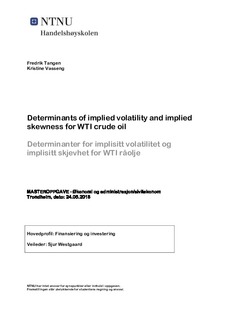| dc.description.abstract | We analyze empirically what drives changes in the volatility smile for WTI crude oil, by calculating at-the-money implied volatility and a proxy for implied skewness on nearby future options from 25.07.2006 to 03.03.2016. To our knowledge no previous research use a proxy for implied skewness when examining what drives changes in implied skewness for WTI crude oil. We examine if macroeconomic conditions, physical oil market fundamentals and financial variables can explain what drives changes in implied volatility and implied skewness. Our results for implied volatility supports the findings of Robe and Wallen (2016). The results for implied skewness shows that physical oil market fundamentals contributes significantly in explaining
changes in implied skewness. Storage capacity in Cushing is proxied by the slope of the WTI crude oil term structure, and is significant when in state of backwardation. Higher degree of backwardation, more available storage capacity, has a positive effect on implied skewness. OPEC spare capacity is close to significant at a 10% level and is measured by a dummy variable. High OPEC spare capacity has a positive effect on implied skewness. In addition the control variable for time to maturity is significant and increasing time to maturity has a negative effect on implied skewness. | nb_NO |
